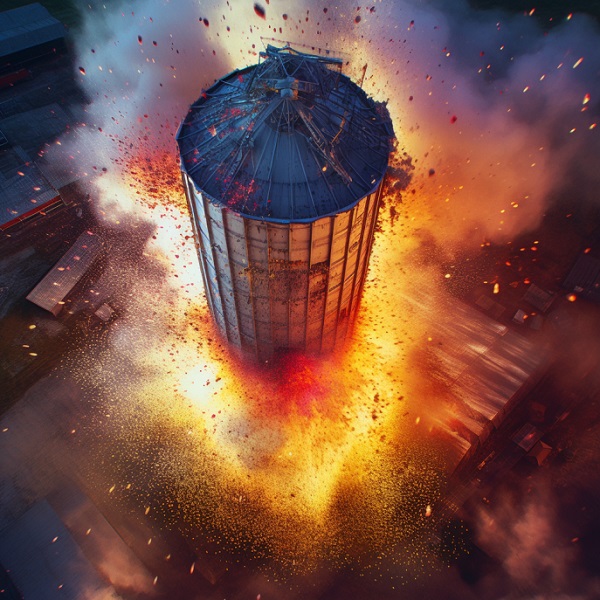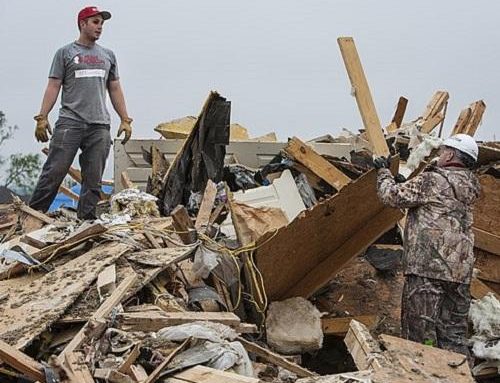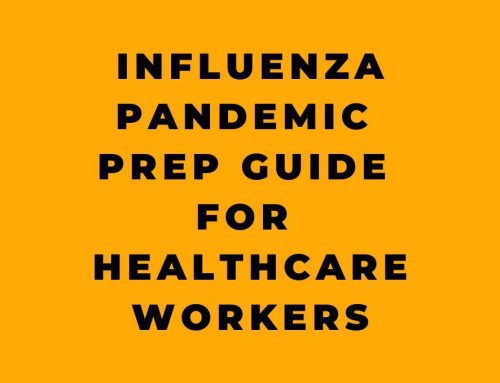Today, let’s talk about something that’s as fine as dust, yet as dangerous as dynamite – that’s right, combustible dust.
Imagine this – you’re in an industrial setting, surrounded by fine particles suspended in air. You may not know it, but these particles can cause a massive explosion, taking down buildings and causing injuries or even death. It’s a silent hazard that many are unaware of until it’s too late.
So, you might be wondering, how does this happen? Well, folks, it’s all about the Dust Explosion Pentagon – oxygen, heat, fuel (the dust), dispersion, and confinement. When these five get together, they party hard, and the result is often a dust explosion. Remove one from the mix, and the party’s over.
But hold onto your hardhats, because it gets worse. An initial explosion can stir up more dust or damage containment systems, leading to secondary explosions. These are often far more destructive due to the sheer amount of dust involved. Talk about a double whammy.
Now, it’s not just the coal mines or the flour mills at risk here. This hazard spans across multiple industries, from agriculture and food production, to pharmaceuticals and even 3D printing. If there’s dust, there’s potential danger.
So, what can we do about it? Well, OSHA recommends starting with a thorough hazard assessment. Look at all materials, operations, spaces, and potential ignition sources. Basically, leave no stone – or dust particle – unturned.
Once you’ve identified the risks, it’s time to roll up your sleeves and get to work. Here are a few dust control tips:
- Implement a rigorous dust inspection, testing, and control program
- Use proper dust collection systems and filters
- Keep dust from escaping equipment or ventilation systems
- Use surfaces that minimize dust accumulation and are easy to clean
- Regularly inspect all areas, even hidden ones, for dust residues
- Use vacuum cleaners approved for dust collection
- Position relief valves away from dust deposits
Ignition control is equally important. Here’s what you can do:
- Use proper electrical equipment and wiring
- Control static electricity – bonding of equipment to ground is essential
- Be vigilant about open flames, smoking, and sparks
- Separate heated surfaces from dusts
- Use an equipment preventive maintenance program
Now, let’s talk about reducing injuries and damage. Here are some methods:
- Keep hazards separate – either by distance or barriers
- Install deflagration isolation/venting and pressure relief venting for equipment
- Set up specialized fire suppression and explosion protection systems
- Develop an emergency action plan and maintain emergency exit routes
OSHA has a set of requirements to follow, including housekeeping, hazard communication, and others. Remember, it’s the employer’s responsibility to keep workplaces free from recognized hazards.
With all that being said, it’s one thing to talk about dust explosions in theory, but it’s a whole different kettle of fish to see how these scenarios play out in real life. In the world of safety, we learn best from the lessons of the past – from the stories of those who’ve been there, done that, and lived to tell the tale.
And let me tell you, those stories can be worth their weight in gold, not just in terms of the lessons learned, but also in understanding the sheer magnitude of the risks involved. It’s like putting a face to a name. So, let’s delve into a few case studies that shed light on the real-world implications of dust explosions. Buckle up, folks – it’s going to be an enlightening ride.
Case Study 1: Imperial Sugar In the heartland of America, something sweet turned deadly. The Imperial Sugar refinery, a stalwart of industry, was brought to its knees by an unseen enemy – combustible sugar dust. Despite its innocent appearance, this dust brought death and destruction in its wake, a chilling reminder of the dangers that can lurk in even the most mundane of substances.
Case Study 2: CTA Acoustics Over in Corbin, Kentucky, an acoustic and insulation products manufacturer named CTA Acoustics experienced a similar tragedy. A dust explosion, ignited by an uncontrolled release of phenolic resin dust, shook the plant to its core, highlighting the critical importance of understanding and managing the risks associated with hazardous substances.
Case Study 3: West Pharmaceutical Services A tale of calamity unfolded at a medical supplies manufacturing plant owned by West Pharmaceutical Services. An accumulation of fine plastic powder in the facility’s overhead ductwork led to a devastating explosion. The impact was felt far and wide, injuring workers and annihilating the facility – a stark demonstration of the repercussions of overlooking seemingly minor safety issues.
Case Study 4: Hayes Lemmerz At Hayes Lemmerz, a manufacturer of automotive wheels, tragedy struck in the form of an aluminum dust explosion. It’s a sobering tale that underscores the dangers of working with machinery that is poorly understood or improperly maintained.
Case Study 5: AL Solutions Last but not least, we find ourselves at AL Solutions, a metal recycler. Here, a series of fatal explosions were triggered by zirconium dust. This catastrophe is a potent reminder that sometimes, the alarm bells don’t ring until it’s too late.
Summary of Case Studies
These case studies paint a somber picture of the dangers of combustible dust in the industrial workplace. Each story serves as a stark reminder that safety must never be taken for granted, no matter how innocuous the substance or routine the operation may seem.
From sugar to metal dust, these tragedies underscore the importance of maintaining a vigilant eye for potential hazards, implementing rigorous safety protocols, and ensuring that all employees are thoroughly trained in recognizing and managing risk.
The lessons here are clear:
- Knowledge is key. Understanding the properties of the materials you’re working with – and the dangers they may pose – is the first step towards prevention.
- Never underestimate “routine” risks. As we’ve seen, even the most seemingly harmless substances can have catastrophic consequences if not handled correctly.
- Stay vigilant. Regular inspections and safety assessments are crucial in identifying potential hazards before they escalate.
- Invest in training. Ensuring that all employees are well-versed in safety protocols not only reduces the risk of accidents, but also empowers them to act effectively if a crisis does occur.
- Don’t ignore the warning signs. If something doesn’t seem right, it probably isn’t. Don’t wait for disaster to strike before taking action.
Remember, safety isn’t just a protocol – it’s a mindset. Let’s learn from these tragedies so they aren’t repeated. As they say, those who cannot remember the past are condemned to repeat it. So, let’s remember and take action.
Resources
Finally, don’t forget to check out resources available on OSHA’s website and the National Fire Protection Association’s standards related to combustible dust. Knowledge is power, after all:
Readily available from www.osha.gov are:
- Combustible Dust National Emphasis Program
- Safety and Health Information Bulletin (SHIB) (0731-2005) Combustible Dust in Industry: Preventing and Mitigating the Effects of Fires and Explosions See the SHIB or www.osha.gov for other applicable standards.
- The primary National Fire Protection Association (NFPA) consensus standards related to this hazard are:
- NFPA 654, Standard for the Prevention of Fire and Dust Explosions from the Manufacturing, Processing, and Handling of Combustible Particulate Solids
- NFPA 61, Standard for the Prevention of Fires and Dust Explosions in Agricultural and Food Processing Facilities
- NFPA 484, Standard for Combustible Metals
- NFPA 664, Standard for the Prevention of Fires and Explosions in Wood Processing and Woodworking Facilities
- NFPA 655, Standard for the Prevention of Sulfur Fires and Explosions
- See www.nfpa.org to view NFPA standards.
Conclusion
In summarizing this comprehensive guide on combustible dust, it is crucial to highlight the often-underestimated power and peril of such a commonplace substance. It is clear that this seemingly harmless material holds the potential for disaster when overlooked in industrial settings. From the perilous dust explosions explained through the Dust Explosion Pentagon to the escalation caused by primary and secondary explosions, it’s apparent that the risk of combustible dust spans across a wide array of industries, from agriculture and food production to pharmaceuticals and 3D printing. The unseen menace requires comprehensive precautionary measures, which can be undertaken through rigorous hazard assessments, proper implementation of dust control and ignition control methods, and strategic injury reduction plans.
Moreover, the importance of practical application of these safety measures is starkly illustrated through the tragic stories from Imperial Sugar, CTA Acoustics, West Pharmaceutical Services, Hayes Lemmerz, and AL Solutions. Each case study underscores the imperative nature of maintaining constant vigilance in the workplace, as well as taking all potential risks seriously, no matter how mundane they might appear. All these lessons should encourage thorough understanding of the substances in use, regular inspections and safety assessments, ongoing investment in employee training, and swift responses to warning signs. Ultimately, fostering a safety-oriented mindset within all personnel is vital. Complacency can lead to catastrophe, as history has repeatedly demonstrated. It is our collective responsibility to ensure these mistakes are not repeated, by constantly learning from past incidents and using that knowledge to shape a safer future.
As a final note, it is crucial to leverage available resources like the ones provided by OSHA and the National Fire Protection Association, as they provide invaluable information on handling combustible dust hazards. The world of safety is not static, but a dynamic field that evolves with every new understanding and discovery. Therefore, staying informed and updated on safety standards is fundamental to maintaining a secure environment. Remember, your safety is ultimately in your hands. To combat the threat of combustible dust, be vigilant, be informed, and above all, prioritize safety. The silent risk of combustible dust need not become a deafening issue if tackled with the appropriate preventative measures.
References:










